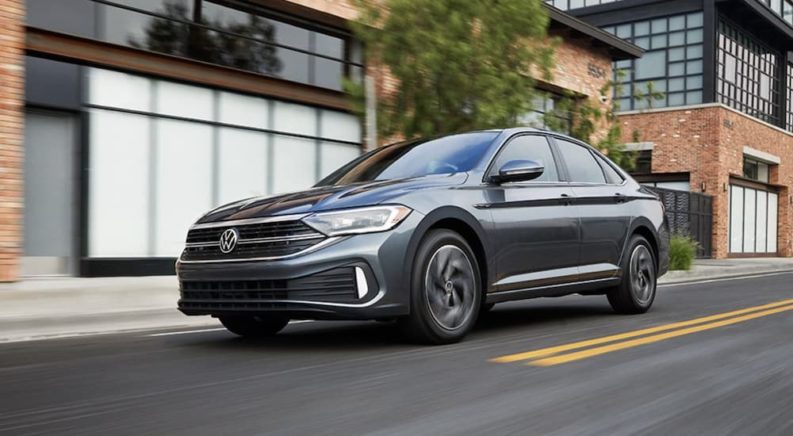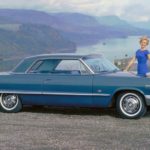When it comes to cars, model names are often just a lot of hot air—something Volkswagen knows better than most. A vehicle’s name can go a long way toward helping it to carve out its identity, but too often brands opt for whatever they think sounds the most modern, sleek, or imposing. Some manufacturers know to have fun with the process, however, and one need look no further than Volkswagen to see a perfect example of a company that’s not afraid to go a little high-concept. With the release of the 2022 Volkswagen Jetta, I thought it would be a good time to look back at one of the Volkswagen OGs and answer a question that’s always bugged me: Just where did that name come from—and, how does it fit into a larger pattern from VW?
VW stands out in the industry for keeping its model names around for much longer than average, and with good reason. Since the mid-70s, the German auto giant has kept rolling out the same beloved models year after year, with names like Jetta, Passat, Beetle, and Golf—winning over drivers generation after generation. We’ll take a deep dive into how the Jetta earned its name and examine a few other uniquely monikered models on offer from Volkswagen.
Ich Bin ein Volkswagener
The German language is often described as harsh, guttural, and hilariously specific. While most languages are content to string together words into longer sentences, ruthless German efficiency seems to dictate that a space bar only be used when absolutely necessary. This results in some unwieldy words that describe entire concepts which, while not entirely unique to German, seems to be far more common in the language. This unusual feature is due to the language’s resistance to noun clusters, which are typically grouped into one word that can encompass as many as four or five individual nouns. One need look no further than the German word for “car insurance” for an example: the tongue-twisting “Kraftfahrzeug-Haftpflichtversicherung.”
While it’s probably more poetic to the ear of a native German speaker, the language can seem very awkward and jagged for those of us on the other side of the Rhine. This impression is widespread enough to have spawned its own meme, with countless iterations of the format sound online. These usually depict a series of friendly cartoon faces giving the translation for a specific word in a variety of different languages, followed by a very angry German cartoon face providing the German equivalent. For example, “van” in English doesn’t change much in France (“van”) and remains relatively uncomplicated in Italian and Spanish (“Furgone” and “Camioneta,” respectively). But then comes German with “KOMBINATIONSKRAFTWAGEN”.
Those looking for a good example of the trend don’t have to search much further than VW itself. Established in 1937, Volkswagen came around at a time when personal automobiles were still a luxury reserved for well-heeled motorists, with only one out of 50 German citizens owning their own vehicle. The Volkswagen—literally, “people’s car”—aimed to change all that by introducing a small, affordable family car that was well within the reach of the average German. These cars were priced at just $396 USD (just under $8,000 in today’s money) and could be purchased through a savings plan for just 5 Marks a week. This spurred the slogan, “Fünf Mark die Woche musst du sparen, willst du im eigenen Wagen fahren” (“Five Marks a week you must set aside, if in your own car you wish to ride”).
VW didn’t get off to a running start when it came to naming its early vehicles, with early prototypes bearing less-than-appealing names like the Kraft durch Freude-Wagen (“Strength Through Joy car”) and Kübelwagen (“Bucket car”). Even the company’s most iconic vehicle would start out with a dry, clinical moniker, as the famous Beetle was originally called the Type 1. The vehicle’s unique, bulbous design quickly earned it the nickname Käfer (“Beetle”) in Germany, and other countries were quick to apply their own unique monikers. The “Bug”, as we might know it in the US, was informally called “The Bubble” in Denmark, “coccinelle” (ladybug) in France, and “Turtle Car” in Thailand. VW kept with its numeric naming designation, introducing the Type 2, 3, and 4 before sales started to falter and VW finally decided to start adding a little flair to the model names.
Then came the 1970s, and the advertising industry was in full force. VW had already made a splash on the market with its brand of minimalist print ads aimed at a younger, hipper generation of drivers; now it just needed some models that rolled off the tongue a little better than the very-guttural, very-German-sounding names of models past.
Blowing in the Wind
This decision would spur many of the VW model names still in use today, including not only Passat, but also Golf, Polo, and Scirocco. The Passat, originally built as a fastback version of the popular Audi 80, would be the first to hit the market, with the Scirocco coupe following in 1974. It was the Golf that represented a real game-changer for the company, proving so popular that VW stopped producing the Beetle at its main Wolfsburg plant following its release. These models would prove popular in Europe and abroad, allowing VW to turn its fortunes around and become a mainstay in the worldwide auto market.
These 70s models also introduced a unique naming convention that would become a theme for the German auto giant. While there is little evidence of where the idea came from, VW landed on a theme in the 70s when it started naming its newly introduced vehicles after various winds. It’s a logical connection for a car company looking to draw an association with speed, and the names allowed VW to break from the dry, clinical nameplates that had accompanied its vehicles up until this point.
The Jetta itself takes its name from the German for “jet stream”, a wind pattern like the trade winds that give the Passat its name, only in reverse. Instead of blowing east to west like the trade winds famously do, jet streams blow west to east. Whereas the trade winds are surface wind patterns, blowing 3,000 to 5,000 feet above the earth, the jet stream occupies a much loftier realm of around 5 to 9 miles. These are the same heights where many modern commercial aircraft operate, giving the stream its “jet” name. The Jetta moniker pulls double duty for VW, keeping with the wind theme established by the Passat while folding the high-speed “jet” concept into the mix at the same time.
A Naming Convention Continues
VW’s best-selling compact, the Golf, is supposedly named after the Gulf Stream—which, on its surface, would fit the brand’s late-70s naming conventions to a T. However, despite what many confident-if-ill-informed people on the internet might think, the Gulf Stream is actually an ocean current, not a wind pattern. That’s not to say it’s wholly inappropriate as a vehicle name: the Gulf Stream is a fast-moving, consistent ocean current. But, the fact that it has such a dramatic warming effect on the world’s climate is an association that any automaker would probably want to leave behind. Maybe VW was hoping that having the word “stream” in there was close enough to fool us, but this is a surprising miss from the usually fastidious Germans.
For its sport compact hatchback, the Scirocco, VW decided to go south of the border. South of *its* border, that is, borrowing another wind-themed name from Italian to create the Scirocco. The Scirocco is one of the eight directional winds of the Mediterranean, blowing northeast from the Sahara desert to bring warm, dusty air to southern Europe. The name is particularly fitting for VW’s sporty hatchback, as Scirocco winds can reach hurricane-force speeds as high as 72 mph. Less fitting for a fine German automobile: the dust typically found in said winds can wreak havoc on sensitive mechanical devices, gritting up their joints and pitting their exteriors.
As for “Vento,” a name VW has used a couple of times throughout its history, the brand gets literal. Vento means “wind” in both Italian and Portuguese. Though it doesn’t refer to a specific type of wind, the connotations with speed serve this sedan well. The Vento name was most recently used on Polo-based sedans sold in India and Mexico.
VW has gone through several different naming conventions in the years since it introduced its first wind-inspired model names, but it continues to have fun with the practice. Modern iterations have carried everything from the names of Greek gods and goddesses (Atlas, Phaeton, and Eos); to Latin words (Arteon for “art”); and tribes of Berber nomads who live in the northern Sahara Desert (Touareg).
It’s not all fun and games, though. The German automaker tends to stick with drier designations for many of its sporty, cutting-edge vehicles like the GLI, GTI, or new all-electric ID.4. But, they know how to cut loose when it’s called for. In fact, when it came time to launch a new SUV in 2009, VW used a German auto magazine’s reader’s poll to land on Tiguan, which is a combination of the German words for tiger and iguana. These names reflect the fun-loving attitude that VW brings to every part of the design process, producing reliable, sporty vehicles that get the job done without ever taking themselves too seriously.




